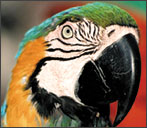
![]()
![]()
![]()
![]()
![]()
CRETACEOUS PARROT
Rifling through a drawer in Berkeley's Museum of Paleontology fossil collection, graduate student Thomas Stidham made another great find recently. He came upon a half-inch-long jaw bone that may prove parrots existed alongside dinosaurs.
If his analysis of the fossil announced in Nature proves correct, this parrot could be the earliest modern land bird ever discovered and the oldest parrot fossil around.
Berkeley paleontologist William Clemens, professor of integrative biology, had excavated the tiny fragment in 1960 in eastern Wyoming and labeled it an unknown avian fossil.
But decades later, Stidham, who likes examining the museum's old bird bones, noticed Clemens' discovery looked parrot-like. An X-ray of the jaw revealed the critical find: its nerve and blood vessel tracks matched those of modern parrots.
To date, Stidham has identified nearly a dozen new species of birds in the campus's paleontology collections.
The bone bit has raised a stir in the paleontology community. Some scientists lauded the find, saying it could show this modern bird survived whatever caused the mass extinction that ended the Cretaceous period. "An asteroid probably hit the Earth at this time," Clemens said, "but the environmental effects of the impact have been greatly exaggerated."
Others felt the tiny fragment was too small to identify.
Separate DNA evidence supports Stidham's parrot theories. Molecular studies of modern birds, including parrots, place their origin in the Cretaceous period -- a nice fit for Stidham's fossil.
![]()
![]()

![]()
[Table
of Contents]
[Berkeley
Magazine Home]
[UC
Berkeley Home Page]
Copyright 2000,
Regents of the University of California. All rights
reserved.
Comments? E-mail ucbwww@pa.urel.berkeley.edu.
